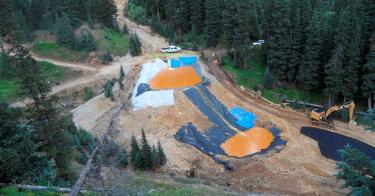Two years ago the Environmental Protection Agency (EPA) dumped 3 million gallons of acid mine drainage and over a million pounds of metal contaminates into Colorado’s Animas River, turning it psychedelic orange.
Commendably, EPA Administrator Scott Pruitt is now taking a second look at previously rejected claims for damages. But it’s also time to hold bureaucrats accountable for hiding the truth of what happened at the Gold King Mine.
It’s been two years since then-EPA Administrator Gina McCarthy promised Congress that “we will follow up and they will be held accountable if there were mistakes made, if they could’ve avoided this, if they forgot to look at something, or made a judgment that wasn’t based on profound engineering and science.” But thus far, no one has been prosecuted and there’s no indication anyone was fired or punished in any way.
That’s hard to imagine, given the agency’s history at the site.
Before the EPA started working at the mine tunnel, a pipe had been inserted to allow continual drainage, and rocks and earth were piled in front of the mine opening to prevent access. After a time, drainage seeping onto the ground outside the entrance declined — a possible indication of contaminated water building up behind a blockage within the tunnel.
The year before the blowout, an EPA crew started to uncover the opening. They stopped when they found old mine timbers standing four feet tall among the rubble. Rather than conclude the timbers were broken or sheared off when the mine entrance was buried with boulders, EPA speculated that the remainder of those timbers (thought to be 10 feet tall) must have been buried. That would mean the mine floor would be six feet lower than the ground outside.
It was a strange conclusion, since available photos and other documents clearly demonstrated that was not the case and because the tunnel was specifically designed to drain the mine.
EPA’s erroneous speculation led it to assume that drainage had pooled within the mine until it rose a bit above ground level and seeped out. With this reasoning, EPA didn’t bother to drill into the tunnel from above to test water pressure.
The agency returned the next year to address the potential “blowout [that could] cause a release of large volumes of contaminated mine waters and sediment.” Despite this, its team chose to recklessly remove part of the natural plug of compacted rocks, timber and clay in the mine’s opening — a fact, along with the strange assumptions, that was omitted from official reports. It was like cracking open a ship’s leaking watertight door — the part in the movie where someone belatedly screams, “No!”
An email sent within 48 hours of the disaster by an official with the Department of the Interior makes this clear. He alerted his colleagues that he had spoken with the EPA’s project leader and that “the EPA was attempting to relieve hydrologic pressure behind a naturally collapsed [tunnel/opening] of the Gold King Mine. While removing small portions of the natural plug, the material catastrophically gave way and released the mine water.”
Photographs show that the EPA crew cleared away the rubble in front the tunnel, uncovering the plug. EPA reports claim the crew stopped messing with the plug at that point so other specialists could deal with it later.
However, other photographs reveal that the crew then reburied the plug, and built an earthen mound in front of the blocked opening, fashioning a channel shored with planks to direct mine water around it. With this makeshift precaution in place and clueless as to the consequence except that it could be really bad, they dug into the plug to see what would happen.
EPA apologists have likened the mine to a ticking time bomb. If that’s the case, the plan outlined in the Interior email could be likened to lighting a fuse and standing back to see what happens.
Since then, EPA has obfuscated, misdirected and lied to cover up what were at best implausible assumptions followed by reckless actions and then use of taxpayer dollars to hide the truth. So far, the bureaucrats responsible have gotten away with it.
At the same time it has argued the bad stuff just washed away, the EPA declared an expansive new Superfund site, something the agency long wanted. And after playing their role in turning the Animas orange, the EPA contractors were almost immediately rehired to address the mess. Having regional contracts, they may be in line for new Superfund work at other nearby mine sites.
With the EPA, it seems, environmental catastrophe or not, you never have to say you’re sorry.
This piece originally appeared in The Washington Times




